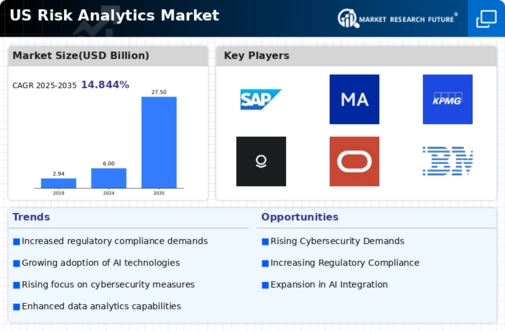Increased Focus on Data Privacy
In the current landscape, the risk analytics market is witnessing an intensified focus on data privacy and protection. With the rise of data breaches and stringent regulations, organizations are compelled to adopt robust risk analytics solutions to safeguard sensitive information. The implementation of frameworks such as the California Consumer Privacy Act (CCPA) has further propelled the need for compliance-driven analytics. Companies are investing heavily in risk assessment tools that can identify vulnerabilities and ensure adherence to privacy regulations. This shift is expected to drive the risk analytics market's growth, as businesses seek to enhance their data governance practices and mitigate potential legal repercussions associated with data mishandling.
Adoption of Cloud-Based Solutions
The risk analytics market is increasingly influenced by the adoption of cloud-based solutions. Organizations are transitioning from traditional on-premises systems to cloud platforms, which offer scalability, flexibility, and cost-effectiveness. This shift allows businesses to access advanced analytics tools without the burden of significant upfront investments. According to industry reports, the cloud segment within the risk analytics market is anticipated to grow by over 30% in the coming years. The ability to analyze vast amounts of data in real-time enhances risk assessment capabilities, enabling organizations to respond swiftly to emerging threats. Consequently, the proliferation of cloud technology is likely to reshape the risk analytics landscape, fostering innovation and efficiency.
Growing Demand for Predictive Analytics
The risk analytics market is experiencing a notable surge in demand for predictive analytics solutions. Organizations are increasingly recognizing the value of leveraging data to forecast potential risks and mitigate them proactively. This trend is particularly evident in sectors such as finance and insurance, where predictive models can enhance decision-making processes. According to recent estimates, the predictive analytics segment is projected to grow at a CAGR of approximately 25% over the next five years. This growth is driven by the need for businesses to stay ahead of emerging threats and optimize their risk management strategies. As a result, the risk analytics market is likely to see a significant influx of investments aimed at developing advanced predictive tools and technologies.
Emergence of Advanced Analytics Technologies
The risk analytics market is witnessing the emergence of advanced analytics technologies, which are reshaping how organizations approach risk management. Innovations such as big data analytics, artificial intelligence, and machine learning are enabling businesses to derive deeper insights from their data. These technologies facilitate the identification of complex risk patterns and trends that were previously difficult to detect. As organizations increasingly adopt these advanced tools, the risk analytics market is expected to expand significantly. Industry forecasts suggest that the market for advanced analytics in risk management could grow by approximately 28% over the next five years. This trend underscores the importance of leveraging cutting-edge technologies to enhance risk assessment and decision-making processes.
Rising Importance of Operational Risk Management
The risk analytics market is increasingly prioritizing operational risk management as organizations recognize its critical role in overall risk strategy. Operational risks, which encompass internal processes, systems, and human factors, can significantly impact business continuity and profitability. As a result, companies are investing in comprehensive risk analytics solutions that provide insights into operational vulnerabilities. The operational risk management segment is projected to grow at a CAGR of around 20% over the next few years. This growth is indicative of a broader trend where organizations are seeking to enhance their resilience against unforeseen disruptions. By integrating operational risk analytics into their frameworks, businesses can better navigate uncertainties and optimize their risk management practices.




















Leave a Comment